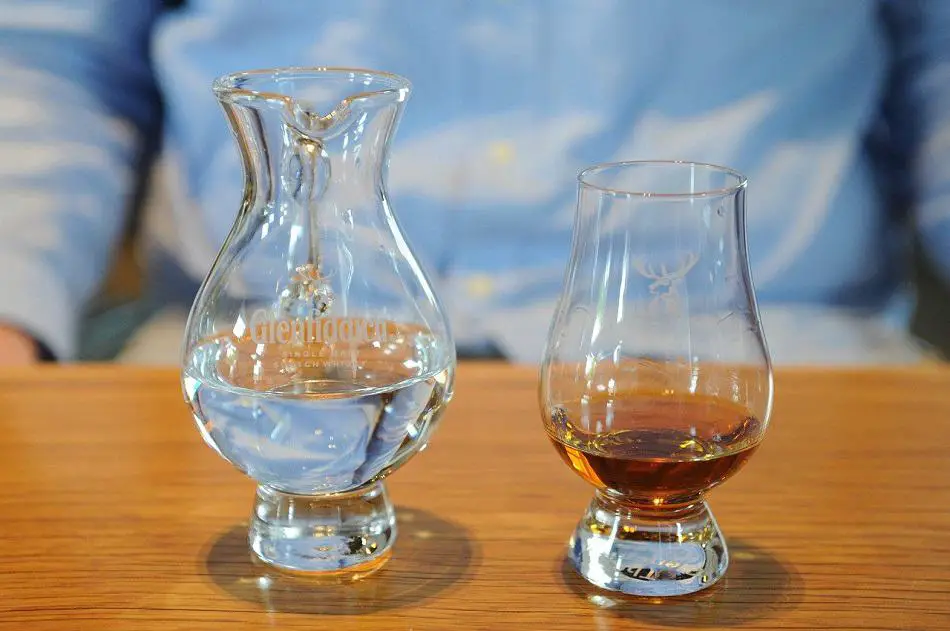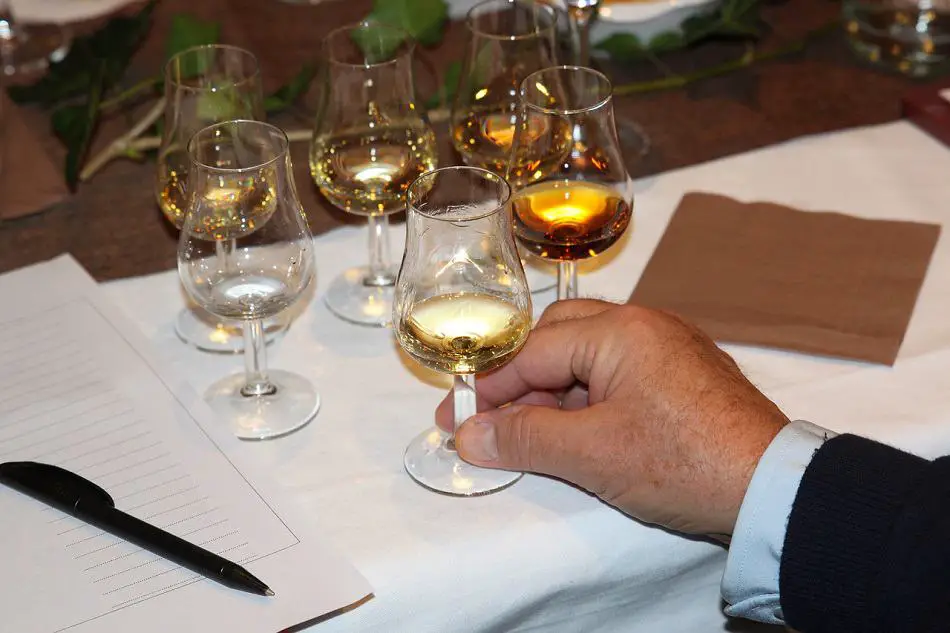If you want to learn how to enjoy whiskey you’ve come to the right place. This was something that I did, and I’m going to take you through the three steps that I took to become someone who loves whiskey.
The three steps to learn how to enjoy whiskey are:
- Reduce the impact of the alcohol
- Find a whiskey you like
- Practice detecting all the aromas and flavors
While it may take a little bit of time to fully appreciate a whiskey, learning to enjoy it is a gradual process, so as soon as you start these steps, you’ll be enjoying whiskey more already. That makes learning how to enjoy whiskey, enjoyable too.

Step 1: Reduce the Impact of the Alcohol
The first step in learning how to enjoy whiskey is to reduce the impact of the alcohol. This is because whiskey can be anywhere from 40%ABV – 68%ABV, meaning it’s very strong indeed.
It’s so strong that the smell and taste of the alcohol overpowers the smell and taste of the whiskey itself. Now the smell and taste of alcohol is not pleasant so it’s no wonder therefore, that many people dislike the smell and taste of ‘whiskey’ but that’s a mistake since what they’re actually smelling and tasting is the alcohol.
Also, if you smell and taste strong alcohol it will numb your nose and palate which as well as being an unpleasant experience makes you unable to smell or taste anything for a while after. Being numb and unable to detect any of the whiskey’s aromas and flavors makes people assume there are none, and that drinking whiskey is only about burning your nose and palate with alcohol.
Yes, it’s tragic indeed.
But fortunately, the solution is simple. If you reduce the impact of the alcohol, you’ll let the delicious aromas and flavors of the whiskey come through. And it’s much easier to enjoy whiskey when you can actually taste it.
There are three things you can do to reduce the impact of the alcohol.
Use a Proper Whiskey Glass


The advantage of using a proper whiskey glass is that it’s designed to reduce the impact of the alcohol and maximize your enjoyment of the whiskey’s aromas and flavors. Proper whiskey glasses or nosing glasses are tall with a wide bowl, a long narrow neck, a thin stem and a broad pedestal.
Since you only pour a little whiskey into the glass, air can get to it allowing the whiskey to breathe. This lets the ethanol evaporate while the whiskey aromas concentrate in the narrow rim. Now you’ll smell less of the alcohol and more of the whiskey’s aromas.
Also, air getting to your whiskey and the ethanol evaporating allows the whiskey’s flavors to open up. This is why some swirl their whiskey and some recommend that when a glass of whiskey is first poured it should be left to sit untouched anywhere from few minutes to a couple of hours. If you sip your whiskey over the course of half an hour you may find the flavors are different for each sip.
On the other hand, using say a shot glass, will do exactly the opposite. Being filled to the brim and with no air getting to the whiskey the ethanol won’t evaporate. With no narrow neck in the glass for the whiskey aromas to accumulate, they will dissipate. That’s why when using a shot glass there are no whiskey aromas, the whiskey’s flavors will remain closed, the ethanol will remain, and when you take a sip, you’ll get a face full of alcohol fumes.
One of the most popular whiskey glasses is the Glencairn Whisky Glass which you can find on Amazon here .
.
Dilute Whiskey With Water or Chill It With Ice
Diluting your whiskey to 35% ABV by adding water, will soften the punch of the alcohol further, preventing your nose and palate from being made numb.
Chilling your whiskey with ice cubes will also reduce the impact of the alcohol. As the temperature is lowered the intensity of the whiskey is diminished and the burn of the alcohol is reduced having less impact.
In both cases the added water that’s reducing the ethanol will also allow the whiskey’s flavors to open up. Since even one drop of water can change the taste of the whiskey, if you’re adding water, add one drop at a time. If you’re adding ice, then you can follow the changes of the whiskey’s flavors as the ice melts.
Acclimatize Yourself to the Alcohol
If you acclimatize yourself to the alcohol, then you’ll be less sensitive to it and it won’t get in the way of your being able to smell and taste the whiskey.
In order to do this, you need to make sure that when you nose (meaning smell) your whiskey that you do so gently. That way your nostrils won’t get singed by the alcohol, they can get used to its strength and you’ll be able to smell some of the whiskey’s aromas.
Similarly, when you taste your whiskey, drink a little sip first so that your mouth can also get used to the alcohol. The first sip will taste overwhelmingly of alcohol but with the second sip you’ll get more of the whiskey’s flavors.
If that doesn’t work because you still find whiskey too alcoholic, then you can try drinking whiskey in a cocktail. This will obviously dilute the whiskey drastically, but it will allow you to enjoy it immediately and get used to it so that when you’re ready you can move on to drinking whiskey neat. There are a large number of delicious whiskey cocktails so there’s a danger you could get stuck at this stage for a very long time.
If the above doesn’t work or you want a quick and sure-fire way of acclimatizing yourself to the alcohol, then you’re going to need to desensitize yourself to its affects by repeatedly drinking alcohol until you get used to it.
You can either drink whiskey every day until it stops burning or start with diluted whiskey and reduce the amount you dilute it each day, until you’re drinking whiskey neat.
Step 2: Find a Whiskey You Like

After reducing the impact of the alcohol, your next step in learning how to enjoy whiskey is to find one or two or twenty that you like. There are many different whiskeys out there, some of which have completely different tastes.
There are whiskeys with dozens of dominant flavors and whiskeys with only one or two. There are whiskeys with delicate or more mild flavors and those whose flavors are bold, intense and rich. There are sweet whiskeys, spicy whiskeys, fruity whiskeys, floral whiskeys and smoky whiskeys.
Common flavors include but are not limited to: honeysuckle, almond, grassy, leather, cream, ginger, toffee, toast, cinnamon, heather, flavor of wet dog – you read that right, dried fruit, apple, honey, nutmeg, vanilla, nuts, oil, seaweed.
Whiskey made from malted barley will be sweet with lots of caramel, toffee and brown sugar notes. If it’s made from corn it will have a sweet syrupy taste, with white sugar, cotton candy, vanilla and maple syrup. If it’s made from rye it will be more spicy, with pepper and cinnamon flavors. If it’s made from wheat it will taste of wheat bread and honey.
To learn more, check out this article that I wrote explaining what whiskey tastes like.
This makes it particularly easy to enjoy whiskey. Simply decide on the flavor or flavors you like and find out which whiskeys have them. Try as many whiskeys as possible and see which have flavors you like, and which have flavors you don’t. With so many options you’re bound to find many whiskeys that you’ll love.
You’re also bound to find many whiskeys you don’t like. Not everyone likes that peaty / smoky flavor many Scotch Whiskeys have. That doesn’t mean you don’t like whiskey. It doesn’t even mean that you don’t like Scotch. It means that you don’t like too much or even any peat. Try a Scotch that’s only lightly peated or one that hasn’t any peat flavor at all.
That’s why when learning to enjoy whiskeys some suggest that you try them in the following order:
Bourbon
In general, American whiskeys have the sweetest taste. Bourbon is the sweetest whiskey due to corn being the most sugary grain used in whiskey production – it’s almost caramel in flavor, and so it’s the easiest whiskey to enjoy. Tennessee whiskey which tastes like bourbon is sweeter according to some.
Next try American rye whiskey which being made from rye is spicier and less smooth.
Irish Whiskeys
When you ready to move on from bourbon, your next step is Irish whiskeys. They’re not too much of a stretch as they can be quite bourbon-like though they’re definitely not as sweet. They’re lighter and fruitier than Scotch Whiskeys, and because they’re triple distilled and usually made without peat, much smoother too.
Scotch Whiskies
Scotch whiskies can be the hardest to learn to enjoy but with five Scotch Whisky regions producing wildly varying types of whiskies, some are easier to learn to enjoy than others.
Whiskies from the Highland and Speyside regions produce lighter, sweeter and fruitier Scotches, so definitely start with them before moving on to the most pungent, peaty and smoky Scotches that come from the region of Islay.
Step 3: Practice Detecting All the Aromas and Flavors

With the alcohol out of the way and knowing what flavors you like, you should already be enjoying your whiskey but if you don’t know how to detect all the aromas and flavors, you’ll be leaving plenty of deliciousness undiscovered.
That’s why the last step in learning how to enjoy whiskey is to practice detecting all the aromas and flavors. All you need is a few tips in nosing and tasting whiskey:
Nosing Whiskey
Flavor is smell as well as taste, so if you want to get the full flavor, you’re going to need to pick up all the aromas.
To do this put your nose into the glass and breathe in deeply but gently – as mentioned you don’t want your nose to be singed by the alcohol. Open your mouth slightly as you inhale to let the alcohol fumes escape and the whiskey aromas to circulate round so you can better discern them.
Sniff using one nostril then the other. Generally, one nostril is responsible for 80% of an inhalation while the other is obstructed. You won’t know which one is which because it alternates every two to three hours. So each nostril will perceive the aromas differently.
Vary your rate of inhalation because some aromas are easier to detect when the flow of air is rapid while others are easier to detect when the flow of air is slower.
Examine every part of the glass because different aromas concentrate at different points. At the bottom you’ll find the heavier compounds with earthy, smoky, woody, aromas and higher up you’ll detect the spicy, malty and winey aromas. Towards the rim will be the lighter, fruity and floral aromas.
Tasting Whiskey
Chew your drink. This means holding it in your mouth and swirling it around. Make sure it spreads throughout your mouth and covers all the surfaces of your tongue – the middle, the sides, the tip and the back – because different parts of your tongue respond to different flavors.
Examine them.
Swallow and take a deep breath, exhaling deeply through your nose so that the aromatic molecules in your mouth go to the back of your throat and rise up into your sinuses. Do not take another sip yet. Wait a moment so that the taste can come back up and you can explore it.
You’ll now be fully enjoying whiskey and wondering how you could have thought any different.

